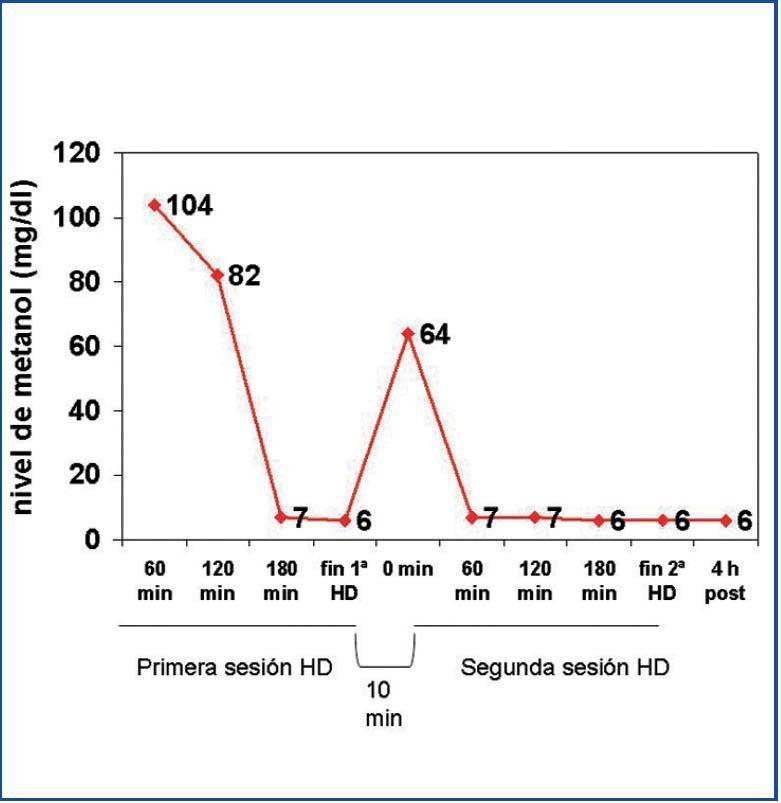To the Editor,
Although rare in our area, and related to accidents or suicide attempts, methanol poisoning is increasing due to the arrival of immigration.1 We report the case of a person with severe methanol poisoning treated with haemodialysis (HD). Serial samples were taken to assess the decrease of blood methanol levels during dialysis.
Case report
A 38-year old male with a history of alcoholism was admitted to the emergency department with visual disturbances, abdominal pain and vomiting.
For days beforehand, he had been drinking perfume and 96° alcohol from a chemists. The day before admission, he voluntarily ingested 200ml of methylated spirit and ethanol (not knowing it was toxic.) He was admitted to the emergency room with blurred vision, unsteadiness, epigastric pain and an episode of vomiting which could not be distinguished as containing blood or not. He also reported fatigue and dyspnoea.
Physical examination in the emergency department
His breathing rate was 40 breaths per minute, with right hypochondrium pain. No bowel sounds were detected. His pupils were dilated, poorly reactive, and he was very sleepy. There was no language impairment, nystagmus or dysmetria in the finger-nose test.
Additional tests in the emergency department
Arterial blood gases: pH 6.99; pCO2 8 mmHg; pO2 138 mm Hg; bicarbonate 3mEq/l.
Biochemistry: glucose 132; urea 32, creatinine 1.15mg/dl; Na 133, K 5.5; Cl 101mEq/l; osmolality 371mOsm/kg.
Haemogram: WBC 23 400 (N 78, C 11, L 9, M 2); Hgb 18.3g/dl; Hct 56%; platelets 264 000.
Osmolar gap calculation: 92.3mOsm/kg (osmolality measurement - {Na [mEq/l] x 2 + urea/6 + glycaemia /18 (mg/dl)}).
Anion gap calculation: 34.5mEq/l ([Na + K] - [Cl + HCO3]).
Methanol poisoning was suspected and 1M bicarbonate was prescribed and the patient was transferred to the ICU, where ethanol infusion is started. The patient was intubated for agitation and respiratory depression. The intravenous route was accessed and HD was begun with the following programme: two consecutive sessions of 4 hours, with a change of filter between, to prevent blood clots and loss of efficiency.
Monitor: Fresenius 4008S (Fresenius Medical Care).
Duration: 4 + 4 hours. Only stopped to change the filter and lines and purge the new system (10 min).
Membrane: polyarylethersulphone (Arylane M9, Gambro). Surface: 2.01m2; UF coefficient 23ml/h/mm Hg, C. urea (Qb 300 and Qd 500, 264ml/min).
Qb (blood flow): 350ml/min, starting at 250ml/min, then after finding good haemodynamic tolerance at 1h, increased to 350ml/min.
Qd (dialysate flow): 800ml/min.
Dialysate: Fresenius A34 supplemented with KCl up to 4mEq/l.
UF: zero.
Anticoagulation: enoxaparin (Clexane) 20 at the start of each session.
Dose of ethanol doubled during the dialysis.
After dialysis the patient improved clinically, and was extubated and transferred to the psychiatric ward the same day.
Hourly methanol extractions were performed (at the start of HD, and then hourly) and 4 hours after ending the second session (Figure 1). The levels were significantly reduced, reaching minimum values after the third hour. However, when stopping dialysis (while changing the filter) a relapse (64mg/dl) was noted, but the patient returned to minimum values after restarting the session.
Discussion
HD2-4 is used for severe methanol poisoning. Its indications are5: blood methanol level >50 mg/dl (not immediately available in our centre), severe metabolic acidosis, visual or neurological disturbances and >30ml methanol intake.
Very prolonged HD sessions have been reported (>1 day).6 Hirsch7 calculates the duration of HD according to levels of methanol [t(hours)=-Vln(5/A)/0.06k, where t is time in hours, V is the volume of body water measured by Watson, A is the level of methanol in blood in mg/dl and k is 80% of urea clearance estimated by the manufacturer]. The level of methanol can be inferred using the osmolar gap, since there is a good correlation between both values,1 minus the normal gap (10-12mOsm/kg). In our case the gap was 92mOsm/kg, which would be about 250mg/dl, with an estimated HD duration of 9 hours.
The fall of methanol in the blood was greater than in the Hirsch study,7 with a relapse while the filter was being changed. This may be because large surface membranes with a high dialysate flow the poison is quickly removed from the vascular compartment, but time is needed for the rest of the poison to be released from the extra-vascular space into the bloodstream.
There are no studies comparing intermittent and continuous HD techniques,1,8 but obviously intermittent HD is always faster. If these findings are confirmed, combining the two techniques should be considered (for example, HD of 3-4 hours followed by the continuous technique) or the Hirsch formula corrected.
Figure 1. Evolution of blood methanol levels during the haemodialysis sessions








